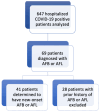Emergence of Atrial Fibrillation and Flutter in COVID-19 Patients: A Retrospective Cohort Study
- PMID: 39273707
- PMCID: PMC11395266
- DOI: 10.3390/healthcare12171682
Emergence of Atrial Fibrillation and Flutter in COVID-19 Patients: A Retrospective Cohort Study
Abstract
COVID-19 is associated with various cardiovascular complications, including arrhythmias. This study investigated the incidence of new-onset atrial fibrillation (AFB) and atrial flutter (AFL) in COVID-19 patients and identified potential risk factors. We conducted a retrospective cohort study at a tertiary-care safety-net community hospital including 647 patients diagnosed with COVID-19 from March 2020 to March 2021. Patients with a prior history of AFB or AFL were excluded. Data on demographics, clinical characteristics, and outcomes were collected and analyzed using chi-square tests, t-tests, and binary logistic regression. We found that 69 patients (10.66%) developed AFB or AFL, with 41 patients (6.34%) experiencing new-onset arrhythmias. The incidence rates for new-onset AFB and AFL were 5.4% and 0.9%, respectively. Older age (≥65 years) was significantly associated with new-onset AFB/AFL (OR: 5.43; 95% CI: 2.31-12.77; p < 0.001), as was the development of sepsis (OR: 2.73; 95% CI: 1.31-5.70; p = 0.008). No significant association was found with patient sex. Our findings indicate that new-onset atrial arrhythmias are a significant complication in COVID-19 patients, particularly among the elderly and those with sepsis. This highlights the need for targeted monitoring and management strategies to mitigate the burden of atrial arrhythmias in high-risk populations during COVID-19 infection.
Keywords: COVID-19; arrhythmias; atrial fibrillation; atrial flutter; elderly; sepsis.
Conflict of interest statement
The authors declare no conflicts of interest.
Figures
Similar articles
-
Outcomes and mortality associated with atrial arrhythmias among patients hospitalized with COVID-19.J Cardiovasc Electrophysiol. 2020 Dec;31(12):3077-3085. doi: 10.1111/jce.14770. Epub 2020 Oct 14. J Cardiovasc Electrophysiol. 2020. PMID: 33017083 Free PMC article.
-
Obstructive Sleep Apnea as a Predictor of Inducible Atrial Flutter During Pulmonary Vein Isolation in Patients With Atrial Fibrillation: Clinical Significance and Follow-Up Outcomes.Cardiol Res. 2023 Jun;14(3):183-191. doi: 10.14740/cr1491. Epub 2023 May 26. Cardiol Res. 2023. PMID: 37304914 Free PMC article.
-
Atrial Fibrillation in Patients Hospitalized With COVID-19: Incidence, Predictors, Outcomes, and Comparison to Influenza.JACC Clin Electrophysiol. 2021 Sep;7(9):1120-1130. doi: 10.1016/j.jacep.2021.02.009. Epub 2021 Feb 24. JACC Clin Electrophysiol. 2021. PMID: 33895107 Free PMC article.
-
Outcomes and mortality associated with atrial arrhythmias among patients hospitalized with COVID-19: A systematic review and meta-analysis.Cardiol J. 2022;29(1):33-43. doi: 10.5603/CJ.a2021.0167. Epub 2021 Dec 13. Cardiol J. 2022. PMID: 34897631 Free PMC article.
-
Atrial fibrillation inducibility during cavotricuspid isthmus-dependent atrial flutter ablation as a predictor of clinical atrial fibrillation. A meta-analysis.J Interv Card Electrophysiol. 2017 Apr;48(3):307-315. doi: 10.1007/s10840-016-0211-9. Epub 2017 Jan 9. J Interv Card Electrophysiol. 2017. PMID: 28070875 Review.
Cited by
-
Clonal Hematopoiesis of Intermediate Potential in Atrial Fibrillation: A Critical View of Current Knowledge as a Springboard for Future Research.Diagnostics (Basel). 2025 Jul 30;15(15):1915. doi: 10.3390/diagnostics15151915. Diagnostics (Basel). 2025. PMID: 40804878 Free PMC article. Review.
References
-
- Zhou F., Yu T., Du R., Fan G., Liu Y., Liu Z., Xiang J., Wang Y., Song B., Gu X., et al. Clinical course and risk factors for mortality of adult inpatients with COVID-19 in Wuhan, China: A retrospective cohort study. Lancet. 2020;395:1054–1062. doi: 10.1016/S0140-6736(20)30566-3. - DOI - PMC - PubMed
LinkOut - more resources
Full Text Sources


